Proper lighting is the key to good mood and well-being. You can make it complete, comfortable and beautiful by using spotlights. Proper selection by size, characteristics and types of lamps – that’s what is needed.
Contents of the article
What is a spotlight
One and the same type of light fixtures has several names: spot, recessed, ceiling. There is also such a name – as “spot”. This is also about a spot light. Just all these words describe the same type of lighting fixtures from different sides.
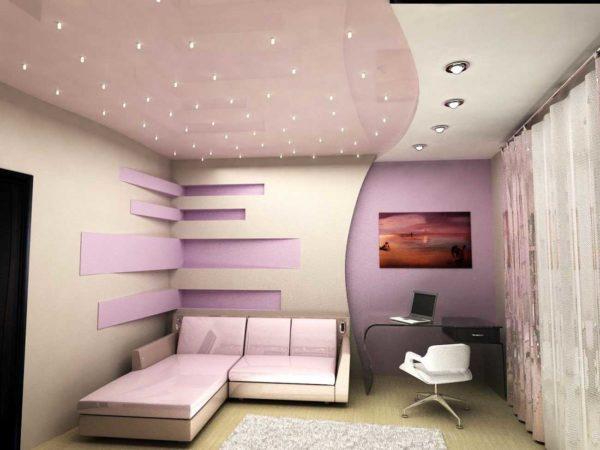
When they say “spot light”, they mean that it creates a narrowly directed stream of light, which creates a spot on the floor and a luminous dot on the ceiling. When they say “recessed” luminaire, they mean the method of installation – on the surface of the ceiling mainly remains only a small decorative part, and the rest of the structure is hidden in the ceiling space. If they talk about ceiling spotlights, they mean the place of installation, as such small-sized structures can be mounted in furniture – in cabinets. The unfamiliar word “spot” is just a Russian version of the English spot, one of the meanings of which is a spot. That is, it also means that the lighting will be in the form of a set of “spots” of light.
Summing up we can say that the spot light is a small-sized lighting device for concealed installation, illuminating a small part of the room. To organize a full-fledged lighting, it is necessary to collect a certain number of such devices and a certain way to place recessed lighting fixtures on the ceiling.
Types, designs, varieties
There is no official classification, and you can only conditionally divide the total mass of these lighting devices into several categories according to different signs. Such a division in the selection process will be easier to navigate, singling out a certain group. No other purpose such a division does not pursue.
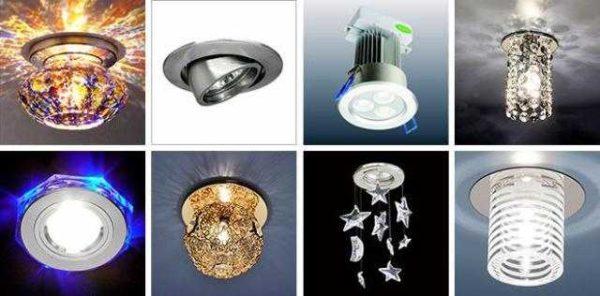
By purpose
This division can be simultaneously considered and division by design, and also – by method of installation. The choice of spotlight on this feature is determined by the type of ceiling in the room. There are two large groups:
They differ structurally and by the method of installation. In models for drywall, two springs are attached to the body. When installing the lamp is connected to the wires, after which the springs are pressed with fingers, the body is inserted into the hole made in advance. The springs diverge, fixing the device on the ceiling.
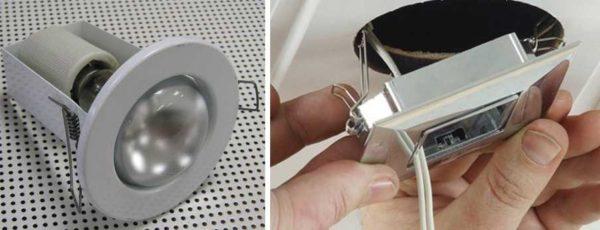
Spotlights for installation in a stretch ceiling on such a mounting system can not be installed – the load-bearing capacity of the film / fabric for this is clearly insufficient. They are attached to the main ceiling on a special sliding bracket, which is used to set the required distance from the level of the main ceiling.
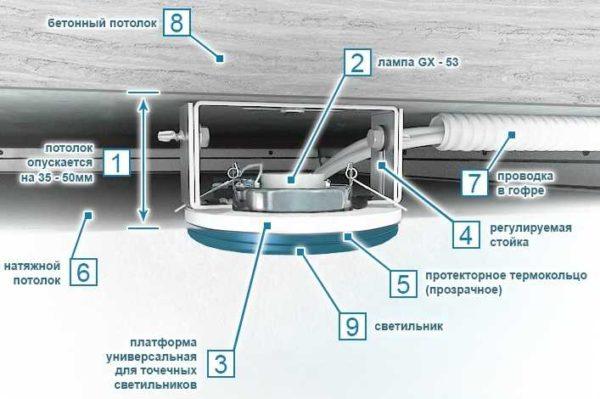
There are models that are immediately complete with this bracket, but they are few. But there are many models to which you can install such a bracket, buying it separately. And it is not always necessary to use exactly the sliding bracket: it can be replaced by a perforated suspension for drywall. Such a design is not so easy to handle (the height is more difficult to set), but it is much cheaper.
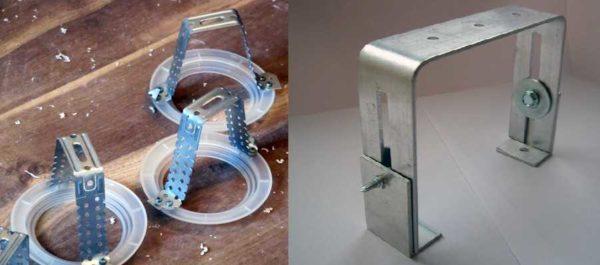
Power supply voltage and degree of protection
The second thing to consider when choosing spotlights is the type of power supply. In ordinary rooms, it is easier to install electrical equipment operating from 220 V. For rooms with increased danger, which includes a bathroom, swimming pool, bathhouse, it is better to choose models that are powered by 24 V or 12 V. When connecting them, a converter (driver) will be necessary, but there are no safety problems.
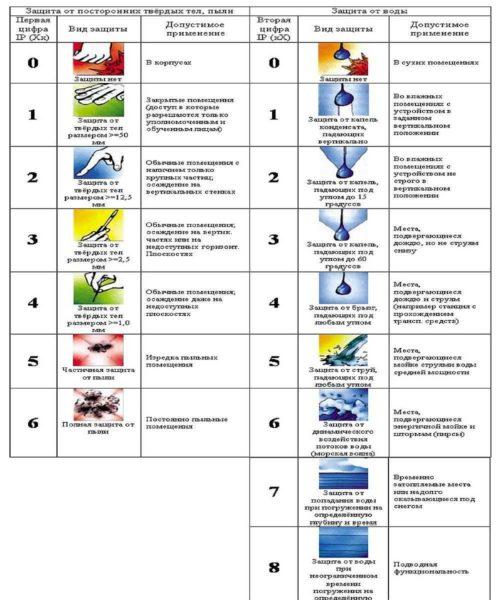
The next point is the degree of protection of the housing. It is also important for premises with difficult working conditions or for operation outdoors. The protection class is indicated by the Latin letters IP and two digits. The first shows the degree of protection against the penetration of hard bodies, the second – against water. For bathrooms and kitchens, it is desirable for the protection class to be at least IP44.
Swivel and non-swivel
Most luminaires do not provide the ability to change the direction of the light flow. There are some models that allow you to rotate the lamp in a fairly large range. They are called swivel.
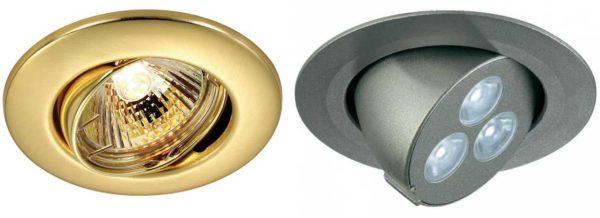
If we talk about the price, then rotary models are more expensive – a more complex mounting system requires more precise manufacturing and more expensive materials. Therefore, it makes sense to use them only in places where it is periodically necessary to change the degree of illumination of some areas.
Surface-mounted
Not all models of spotlights are mounted “flush” with the ceiling level. There is a fairly large group of surface-mounted. In this case, only the wire goes into the ceiling space, and the body is below the ceiling level. In almost all of them, the lamp is fixed permanently, but there are also swivel models.
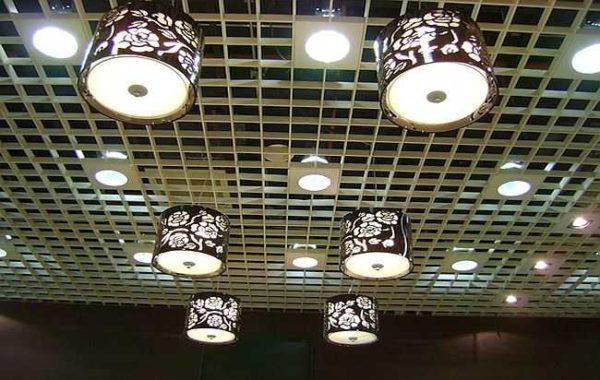
They are used as a design component, but they also allow you to almost not lower the ceiling relative to the base ceiling, which is very important in some situations. The second positive point is that most of the heat from the lamp is dissipated in space. Also during installation, a heat-insulating pad can be placed under the housing for even better protection against heat.
Number of lamps
Most recessed luminaires are designed to connect one lamp. But there are models with two to ten lamps in one housing.
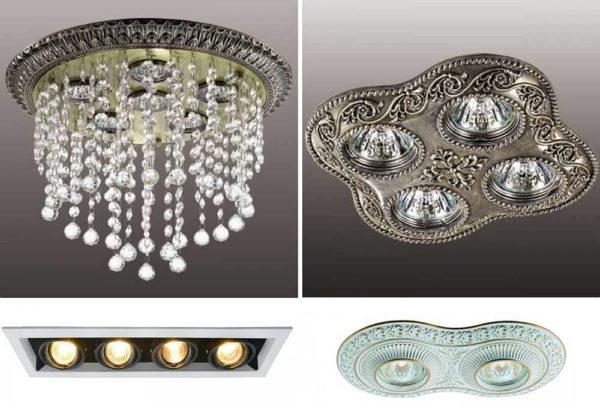
Such models are in different styles and layout options. There are not as many as single-lamp models, but there are quite a few. Difficulties can arise if you need five or more lamps. You’ll have to look for them, especially if you need a specific design, and they are often supplied to order – demand is too limited.
Dimensions
When choosing spotlights, pay attention to their dimensions. In addition to the outer ones, which determine the size of the holes to be cut, you should look at the height. From this parameter depends on how much you have to lower the new ceiling relative to the base ceiling. From the highest point of the lamp to the base ceiling should be a distance of at least 5 cm.
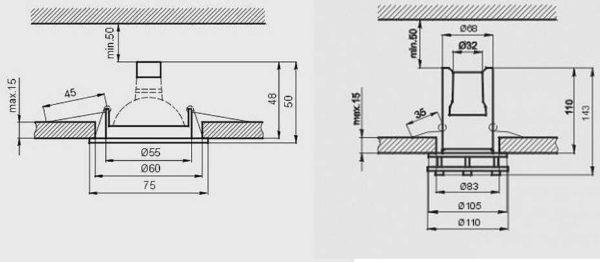
This gap is necessary for effective heat dissipation of working lamps. Also in the ceiling space cables are laid, caster plates for mounting chandeliers, etc. are mounted.
Type of lamps used
Four types of lamps can be used for lighting:
- incandescent;
- halogen;
- compact fluorescent;
- LED.
Incandescent lamps are very rarely used today. In this case, the point is not so much that they “pull” a lot of electricity, although this is also an important factor, especially if there are a dozen or more lamps on the ceiling. Much worse is the fact that they are strongly heated, and heating has a bad effect on the material from which the ceiling is made. If you look at the range of a solid online resource, spotlights for incandescent lamps will be hardly a dozen, but for other positions there are hundreds, sometimes even more than a thousand.
| Incandescent lamps | Fluorescent and energy saving lamps | LED | Luminous flux |
|---|---|---|---|
| 20 W | 5-7 W | 2-3 W | 250 Lm |
| 40 W | 10-13 W | 4-5 W | 400 Lm |
| 60 W | 15-16 W | 6-10 W | 700 Lm |
| 75 W | 18-20 W | 10-12 W | 900 Lm |
| 100 W | 25-30 W | 12-15 W | 1200 Lm |
| 150 W | 40-50 W | 18-20 W | 1800 Lm |
| 200 W | 60-80W | 25-30W | 2500 Lm |
For the same reason halogen lamps are little used, but their range is still more – they are more economical and due to the metallization of part of the body can dissipate some of the heat forward. But still, more common compact fluorescent lamps and increasingly popular are becoming LED. The latter are so in general and economical, and warm much less than all the others, and there are lamps with different bases, different power. What else is good that LED lamps can have a different angle of dispersion – from 30 ° to 360 °, which allows you to achieve different effects in lighting. There are also LED spotlights, in which there are not lamps, but embedded LEDs. They are characterized by a small thickness, which allows you to lower the clear ceiling to a very low height. So this is a really good option.
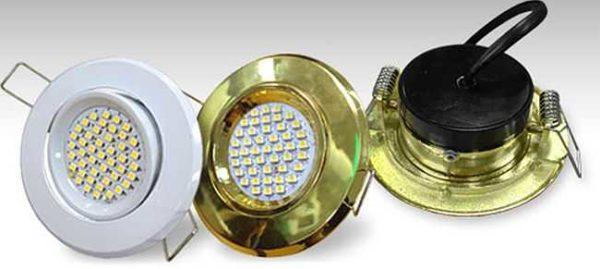
The only downside of LEDs is that they flicker. Approximately the same as fluorescent lamps. Visually it is not noticeable, but, they say, it is harmful to the eyes. Although from personal experience I can say that with this light is much easier to read and eyes are less tired (used to stand before the economy). As before, you can smooth this effect by installing one incandescent lamp in the room.
When choosing a spotlight, look at what types of lamps it works with. Note that there are options in which the lamp is already included in the price, but in many they must be bought separately.

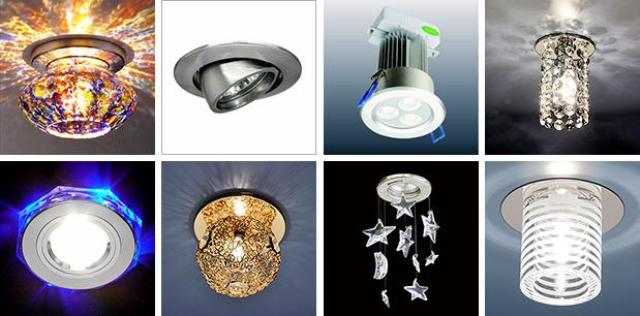
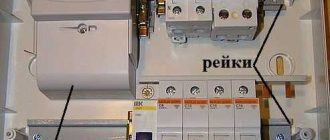




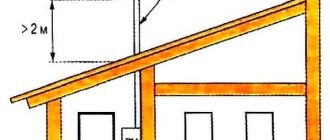
Choosing spot ceiling lights can be tricky! I once picked some that looked great but didn’t brighten my room enough. Make sure to check the lumens and beam angle. Also, consider the style—something that fits your decor! A little planning goes a long way!